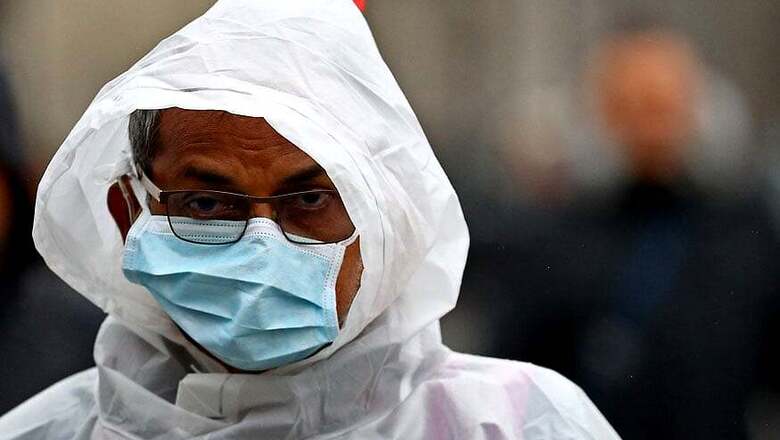
views
As the coronavirus spreads around the globe, the reality is that most of us will probably get it at some point. Fortunately, a vast majority of people will develop only mild to moderate symptoms that will not require hospitalization.
Even so, many people remain frightened about the uncertainty of getting sick with a new disease, and wonder how and when to seek medical care. Here’s what to do if you, or someone in your family, develop symptoms or test positive for infection with the coronavirus.
How do I get tested, or get my family member tested?
It’s very possible that even if you have the virus, you will never be tested for it. This is frustrating to people who have symptoms and want to know if they should isolate themselves and warn their friends about potential exposure. But right now, widespread testing of everyone with symptoms is not happening. If you have flulike symptoms, you should assume you have the illness and take precautions. Call your doctor for guidance.
Call your doctor first. Don’t just show up.
If you’re worried (and have symptoms that would send you to the doctor during normal times), call your family doctor and ask for guidance. You can also call an emergency room for advice. The important thing is that you shouldn’t just show up. Hospitals have plans for the arrival of potential coronavirus patients, to protect staff and other patients, so call ahead.
Don’t rush to the emergency room.
Emergency room waiting rooms are packed with very sick people and overworked staff and doctors. It’s not a place you want to be, and if you show up unnecessarily, you’re taking care away from people who really need it. Before going to the ER, stop and ask yourself, “Would I go to the ER for these symptoms (a cough or fever) under normal circumstances?” In most cases, the answer is probably no. Coughs, fevers, sore throats and runny noses have rarely been an emergency in the past, and those symptoms, even if due to the coronavirus, won’t be an emergency in most cases. Call your doctor.
Q.When should high-risk patients seek care?
Patients at high-risk should check in with their doctors as soon as they have symptoms. A doctor who knows your situation can help you navigate the system and advise you on how and when to seek treatment. High-risk patients include the elderly as well as people with asthma or lung disease, or a history of pneumonia, heart disease, kidney disease, diabetes, a compromised immune system because of illness or a drug therapy, or a person has recently been treated for cancer.
Q.What are the warning signs that should cause concern for otherwise healthy people?
The US Centers for Disease Control and Prevention said the following symptoms should prompt you to seek emergency treatment.
— Difficulty breathing
— Persistent pain or pressure in the chest
— Confusion or inability to arouse
— Bluish lips or face
— Any other symptom that is severe or concerning
Q.How should we care for people at home who have symptoms or have tested positive for the virus?
Many people who have the coronavirus will not stay in a hospital and will be isolated at home. If you have all of the symptoms of the virus but haven’t been tested, you should assume you have it and still take precautions.
Caring for someone with mild to moderate symptoms of the coronavirus is similar to caring for someone with the flu. Give them supportive care, fluids, soups and Tylenol (Paracetamol), and have them take their temperature regularly. If a person is so sick or weak that he or she can’t eat, drink or go to the bathroom, call a doctor. The World Health Organization has guidelines on home care for patients with suspected or confirmed cases of the coronavirus.
Q.Should I take special precautions?
Yes! The patient should be confined to a separate room with no or minimal contact with the rest of the household (including pets), and should use a separate bathroom if possible. Most of the time, a sick person will feel miserable, but he or she can pick up food trays left at the door and sanitize a shared bathroom after using it. (This may not be the case with young children.) If you have masks at home, both patient and caregiver should wear them when in contact with each other.
Make sure that shared spaces in the home have good airflow by turning on an air-conditioner or opening a window. Don’t share dishes, towels or bedding with a sick person.
Q.How can I clean up when my family member is at home and sick?
If a sick person can be isolated in the home, you should try to reduce cleaning in their area as much as possible to avoid unnecessary contact with the ill person. The CDC recommends providing cleaning supplies — tissues, paper towels and disinfectants — for an ill person’s bedroom and bathroom (unless it’s a small child or a person with disabilities). If family members must share a bathroom, the ill person should do their best to clean and disinfect it after each use. Caregivers should wait as long as is practical after use by an ill person to enter and to clean and disinfect high touch surfaces. Always wash hands thoroughly after cleaning.
If you are sharing spaces with a sick person, you should wear gloves and disinfect door knobs, light switches, faucets, toilets and any other high-touch areas the patient has used. Read the CDC’s guidelines on cleaning and disinfecting a home shared with someone with a suspected case of the coronavirus.
Q.Can the rest of the family go about its business?
No. If one person is infected or suspects they have the coronavirus, the sick person should isolate and the whole household should quarantine in the home for 14 days, according to public health officials. If you don’t have a confirmed test, but the family member is exhibiting all of the symptoms of the virus, you should probably err on the side of caution and stay quarantined.
Q.How long will it take for a sick person to recover?
Most people will feel better after a week, according to the CDC.
Q.When can we end home isolation?
A hospitalized patient will typically be released after two negative tests, 24 hours apart. But because there is a shortage of tests, many people recovering at home will not receive a follow-up test to determine if they are still contagious.
Guidelines are changing rapidly. The WHO recommends that patients isolate for 14 days after symptoms have resolved.
— No fever for at least 72 hours (that is, three full days of no fever without the use of medicine that reduces fevers)
— Other symptoms are gone (cough and shortness of breath have improved)
— And at least seven days have passed since the patient’s symptoms first appeared.
Tara Parker-Pope c.2020 The New York Times Company


















Comments
0 comment